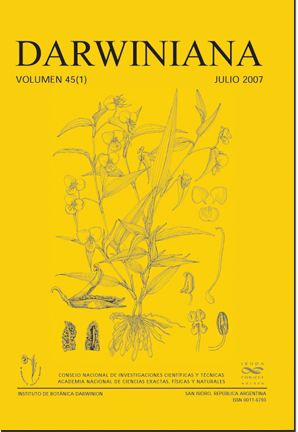Hair formation in the agarophyte alga Gracilaria chilensis (Gracilariales, Rhodophyta)
DOI:
https://doi.org/10.14522/darwiniana.2014.451.96Keywords:
Florideophyceae, Gracilaria, hair, Rhodophyta, ultrastructureAbstract
Gracilaria chilensis (Gracilariales) is an agarophyte red alga belonging to class Florideophyceae. The purpose of this study was to describe the hair formation mechanism. Thalli were maintained in culture with enriched seawater under controlled conditions of light and temperature. Hair formation was induced on portions of thalli growing in a nitrogen-free culture medium. Light (bright field) microscopy, transmission and scanning electron microscopy techniques were used. Hairs develop fromlarge ovoid hair-producing cortical cells (HPCs). These cells are multinucleate, contain small plastids, and abundant endoplasmic reticulum apically positioned. Each hair begins as a protuberance initially covered by a multilaminar wall, this is, in turn, ruptured along with the thallus wall as the protuberan-
ce elongates. Hairs are formed when cytokinesis occurs at the base of the protuberance. An asymmetric pit plug is formed between the hair's base and the HPC. Hairs are unicellular, with a vacuole and numerous nuclei. They have an active growth, and leave a concentric scar on the wall after detachment. Hair formation mechanism in G. chilensis is also compared with that observed in other species of the same class. In nitrogen-free culture media, the thallus of G. chilensis grows less, but the number of hairs increases.
Downloads
Published
31-07-2007
How to Cite
Garcia, M. D., Miravalles, A. B., & Leonardi, P. I. (2007). Hair formation in the agarophyte alga Gracilaria chilensis (Gracilariales, Rhodophyta). Darwiniana, Nueva Serie, 45(1), 7–12. https://doi.org/10.14522/darwiniana.2014.451.96
Issue
Section
Structure and Development
License

Starting on 2012, Darwiniana Nueva Serie uses Licencia Creative Commons Atribución-NoComercial 2.5 Argentina .






